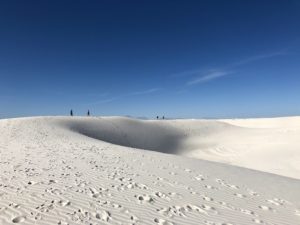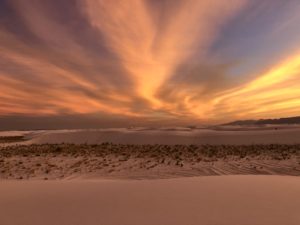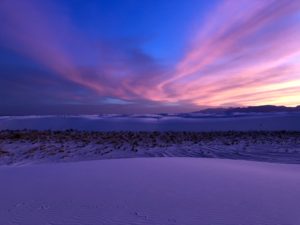 White Sands National Monument is one of the most beautiful spots in the world. It ranks up there with the scenery I saw in New Zealand and along Iceland’s Laugavegur Trail. That is, it’s a place of fairy-tale-like beauty. The prettiest views occur at sunset, when light explodes across the snowy gypsum sand dunes in an array of colors.
White Sands National Monument is one of the most beautiful spots in the world. It ranks up there with the scenery I saw in New Zealand and along Iceland’s Laugavegur Trail. That is, it’s a place of fairy-tale-like beauty. The prettiest views occur at sunset, when light explodes across the snowy gypsum sand dunes in an array of colors.
But let’s back up a little. White Sands lies in south-central New Mexico’s Tularosa Basin, which is part of the Chihuahuan Desert. At 176,000 acres, it is the largest gypsum dune field in the world. The next two largest measure a mere 2,000 acres (Salt Basin dunes in Texas’ Guadalupe Mountains) and 250 acres (Cuatrociénegas in Coahuila, Mexico). Only a handful of other gypsum dune fields exist.
Gypsum Dunes at White Sands
Gypsum is a mineral. It’s found in drywall, plaster of Paris, food, household goods and more. In fact, park signs declare you’ll eat 28 pounds of gypsum during your lifetime.
The gypsum in these dunes starts out as rock high up in the surrounding San Andres and Sacramento Mountains. Water regularly washes gypsum particles from the rock down into the Tularosa Basin. Here, wind and freeze-and-thaw cycles break the particles down into smaller and smaller pieces. The wind also grinds them against each other, which polishes them into beautiful, bright-white grains of sand.
Although fierce winds regularly blow across the Tularosa Basin, the wind never carries the sand off. That’s partially because the dunes are held in place by water, which lies just beneath the surface. In addition, the basin has no outlet. So with nowhere to go, and with the water helping to hold it down, the dune field survives.
Exploring White Sands
White Sands is easily explorable. If you have two days, that will be plenty of time to enjoy the entire monument. Begin by stopping in at the visitor center and going through the small museum. The museum explains the monument’s history and the dune field’s creation. Then you have a choice of three main activities: sledding, hiking and camping.
Let’s talk about the sledding first. Yes, you can sled down sand dunes. It’s not as easy as sledding in snow, though, and it helps if you use a particular type of plastic saucer. The White Sands gift shop sells these for about $20. If your saucer survives your sledding adventure without damage the gift shop will buy it back for about $5.
If sledding isn’t your thing, or when you tire of it, there are five hiking trails in the park totaling 8.9 miles. All showcase different aspects of the dune field. And all can be accessed from Dunes Drive, a winding, eight-mile road that ends in a loop.
Three of the five trails are short and easily navigable (from .4 to 1 mile in length). A fourth trail is two miles long and winds past the monument’s 10 campsites. The final trail, Alkali Flat, is five miles and takes from two to three hours to hike. That’s because the trail winds up and down undulating sand dunes, and you have to navigate by hiking blaze-to-blaze.
When you’re on the Alkali Flat trail, you will pass by an area where signs tell you to stay on the trail because there may be unexploded ordnance nearby. Yes, it’s true, because the monument is adjacent to White Sands Missile Range. This is the spot where the world’s first atomic bomb was detonated in 1945.
Camping Is the Best
There are 10 campsites in White Sands, and up to six people can camp at each site. The campsites are set at the bottoms of sand dunes and are very spacious, yet private. While they can hold many more than six campers, the National Park Service limits the number of campers each night to preserve theses precious, rare dunes. This also means it’s not easy to get a campsite.
To get a spot, park officials recommend arriving at the park at 7 a.m., when the gates first open. The office issuing the camp permits doesn’t open until 9 a.m., but the two-hour wait is worth the chance to snag one of the campsites. If you arrive early and just miss the cut, you can ask some of the people who got sites if they’d mind sharing with you. When I visited I was #8 in line and got a spot, then let three other people share it with me.
The best part of camping at White Sands is watching the sunset. Words cannot describe how beautiful it was, but a look at my photos gives you can idea. Sunrise was beautiful, too.
I’m still in awe of this place, which New Mexico’s Congressional delegation is trying to get classified as a National Park.
If you want to read more about White Sands, and see lots of great sledding photos, check out this article on MojoTraveler by writer-photographer duo Diana Lambdin Meyer and Bruce Meyer.
My top recommended piece of gear for White Sands: My Black Diamond trekking poles. Hiking up sand dunes can be difficult, and trekking poles are invaluable, especially on steep dunes
As an Amazon Associate, I may earn from qualifying purchases. This doesn’t affect the price you pay.




